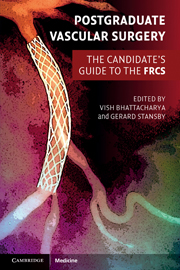Book contents
- Frontmatter
- Contents
- List of contributors
- Preface
- Section 1 Final FRCS vascular clinicals
- Section 2 Final FRCS vascular topics
- 1 Vascular risk factors and their management
- 2 Management of acute limb ischaemia
- 3 Chronic lower limb ischaemia, critical ischaemia and the diabetic foot
- 4 Endovascular and surgical options for peripheral revascularisation
- 5 Abdominal aortic aneurysms
- 6 Thoracic, thoracoabdominal and suprarenal aortic aneurysms
- 7 Aortic dissection
- 8 Popliteal artery aneurysms
- 9 Femoral artery aneurysms
- 10 Carotid, subclavian and vertebral disease
- 11 Diagnosis and management of thoracic outlet syndrome
- 12 Diagnosis and management of hyperhidrosis
- 13 Chronic mesenteric ischaemia
- 14 Acute ischaemic colitis
- 15 Vascular trauma
- 16 Indications and management of lower limb amputation
- 17 Leg swelling and lymphoedema
- 18 Varicose veins and chronic venous insufficiency
- 19 Management of deep vein thrombosis
- 20 Infection in vascular surgery
- 21 Vascular malformations
- 22 Vasospastic disorders and vasculitis
- 23 Critical care considerations and preoperative assessment for general and vascular surgery
- 24 Access surgery
- 25 Basic outline of solid organ transplantation
- Index
- References
12 - Diagnosis and management of hyperhidrosis
- Frontmatter
- Contents
- List of contributors
- Preface
- Section 1 Final FRCS vascular clinicals
- Section 2 Final FRCS vascular topics
- 1 Vascular risk factors and their management
- 2 Management of acute limb ischaemia
- 3 Chronic lower limb ischaemia, critical ischaemia and the diabetic foot
- 4 Endovascular and surgical options for peripheral revascularisation
- 5 Abdominal aortic aneurysms
- 6 Thoracic, thoracoabdominal and suprarenal aortic aneurysms
- 7 Aortic dissection
- 8 Popliteal artery aneurysms
- 9 Femoral artery aneurysms
- 10 Carotid, subclavian and vertebral disease
- 11 Diagnosis and management of thoracic outlet syndrome
- 12 Diagnosis and management of hyperhidrosis
- 13 Chronic mesenteric ischaemia
- 14 Acute ischaemic colitis
- 15 Vascular trauma
- 16 Indications and management of lower limb amputation
- 17 Leg swelling and lymphoedema
- 18 Varicose veins and chronic venous insufficiency
- 19 Management of deep vein thrombosis
- 20 Infection in vascular surgery
- 21 Vascular malformations
- 22 Vasospastic disorders and vasculitis
- 23 Critical care considerations and preoperative assessment for general and vascular surgery
- 24 Access surgery
- 25 Basic outline of solid organ transplantation
- Index
- References
Summary
Key points
Postganglionic sympathetic C fibres supply the sweat glands
Iontophoresis involves passing a small current into the skin using tap water
Botox injections are useful for axillary, palmar or frontal hyperhidrosis but repeat injections are required
Thoracoscopic sympathectomy of T2 and T3 ganglion for palmar and T2 T3 and T4 ganglia for axillary hyperhidrosis is very effective
Patients should be warned of side effects such as compensatory hyperhidrosis, Horner's syndrome, pneumothorax and haemothorax
Local surgical treatments include curettage, skin excision or liposuction
Introduction
Hyperhidrosis is the production of excessive quantities of sweat, and is caused by hyper-function of the exocrine sweat glands, which are controlled by the sympathetic nervous system via postsynaptic cholinergic fibres.
Nerves from the hypothalamic preoptic sweat centre synapse in the intermediolateral cell columns without crossing. The myelinated preganglionic fibres pass out in the anterior roots to the sympathetic chain. Unmyelinated postganglionic C fibres arising from the sympathetic ganglia join the peripheral nerves and pass out to the sweat glands.
Sweating can be induced by thermal stimuli and emotional stress. Emotional sweating can occur over the entire skin but is more prevalent in the palms, axillae and soles. This stops during sleep when thermal sweating can continue.
A dysfunction of the central sympathetic nervous system, possibly of the hypothalamic nucleus or prefrontal areas is suspected to be the cause of hyperhidrosis.
Hyperhidrosis may be primary or secondary; localized or generalized. Secondary hyperhidrosis may be due to hyperthyroidism or phaeochromcytoma.
- Type
- Chapter
- Information
- Postgraduate Vascular SurgeryThe Candidate's Guide to the FRCS, pp. 152 - 155Publisher: Cambridge University PressPrint publication year: 2011



